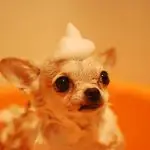Akita
Description:
The Japanese Akita, the Akita or the Akita dog is also known as the Akita Inu. Akitas are the largest of the Japanese Spitz-type dog breeds. The Akita is a strong, muscular and heavily boned dog. The dogís head is large with a short powerful muzzle. The breedís eyes are small and the triangular ears lean forward to provide the characteristic hooded appearance. The dog has a long back and a high set tail that curls over the back. Male dogs are large ranging from 26 to 28 inches and female dogs from 24 to 26 inches at shoulder height. Akitas can weigh from 75 to 120 pounds. This breed has a coarse straight, waterproof outer coat with a soft dense undercoat. All colors are acceptable with red or brindle with a white background being the most common. Dogs can have a black or white mask or none at all.
Japanese Akitas are members of the American Kennel Club (AKC) Working Dog Group.
Japanese Akita Pictures:
Click On Image To Enlarge
History:
The Akita is the national dog of Japan and is native to the island of Honshu in the mountains of the Akita Prefecture. The breed is about 300 years old and was originally developed as a guard dog, then as a hunting dog and finally as a police dog. Today the breed is mainly used as a companion and family dog. Akitas are ranked 51st out of 154 dog breeds in 2004 AKC registrations.
Temperament:
The breed can be impulsive and playful as well as calm and docile. This dog is large, strong, intelligent and eager to please its master. Akita puppies and adolescents require early obedience training if they are to be raised as family dogs with children. The breedís guarding instincts can be a problem with strangers and even strange children. Akita puppies should be socially trained to accept strangers and strange children. Because the dogs were bred to be bold and fearless hunters and fighters, they must undergo firm, fair and sensitive obedience training to curb their tendency to fight with other dogs. Akitas have long-term memories and canít be ignored otherwise they will become resentful. The breed requires lots of attention otherwise it will become domineering and even problematic with children. Akitas should always be supervised around small animals and small children. Children should be taught not to tease these dogs. These dogs can be trained to be good watch dogs and
alert and protective guard dogs. These dogs do best with experienced dog owners.
Exercise:
This breed needs moderate exercise especially in cold weather. Akitas have webbed feet and are very good swimmers and enjoy swimming. They requite a house with a fenced backyard and not a suitable apartment dog unless exercised frequently.
Grooming:
Akitas shed their coats twice per year. These dogs should be brushed regularly with a firm bristle brush and bathed only when dirty. Bathing will remove the protective oils from their coats.
Health Issues:
This breed has a life expectancy from 10 to 13 years. Akitas are prone to a number of health problems including: hip dysplasia, knee problems, thyroid problems, eye disease and eczema. Information on some of these genetic diseases can be found in our article Hereditary Diseases in Dogs.
Article type: xdogbreed


